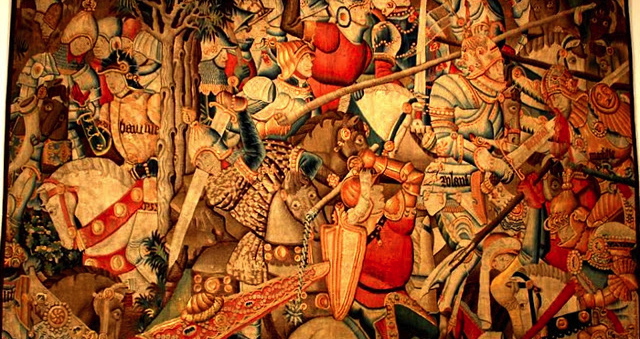 Today, August 15, marks the 1,233rd anniversary of the Battle of Roncesvalles, a pitch battle fought by a contingent of Charlemagne’s army led by Roland, the prefect of the Breton March, against a Basque attack on the Roncesvalles pass while Roland’s men were on the retreat. This battle gave birth, about four-hundred years later, to one of the most celebrated epic poems in French literature, Le Chanson de Roland (The Song of Roland). Written in Middle French, it is celebrated as a landmark of French vernacular literature.
Today, August 15, marks the 1,233rd anniversary of the Battle of Roncesvalles, a pitch battle fought by a contingent of Charlemagne’s army led by Roland, the prefect of the Breton March, against a Basque attack on the Roncesvalles pass while Roland’s men were on the retreat. This battle gave birth, about four-hundred years later, to one of the most celebrated epic poems in French literature, Le Chanson de Roland (The Song of Roland). Written in Middle French, it is celebrated as a landmark of French vernacular literature.
The earliest copy of the Chanson dates back to ca. 1098, in the midst of the First Crusade. It is part of a larger piece of work titled Chansons du Geste.
The story, as the anonymous author relates it in his poetic genius, is cast as a major battle between Charlemagne’s Christian paladins against the infidel forces of Marsila, the Saracen king of Zaragoza.King Marsila, who reigns in the last remaining stronghold of Zaragoza, devises a plot to fool Charlemagne into leaving Spain for good. He promises Charlemagne that he will be his vassal, and convert to Christianity, in return for him leaving Spain. Once back in France, however, Marsila reneges on his promise, and Charlemagne and his paladins, now in no mood to keep fighting the long war, plan to send an embassy to Marsila to negotiate on the agreed settlement.
Roland, a true, brave and faithful paladin, chooses his stepfather Ganelon to head the envoy. Ganelon, who plays the part of Judas in the story, would betray his stepson because of a long-held hatred and jealousy towards him. He views Roland’s choosing him for this mission as a way to have him killed, given the potential danger involved. Once he is received at Marsila’s court, he concludes a plot to have Roland killed by telling the Saracen king that he could attack the rear guard as Charlemagne leaves Spain. The one leading the rear guard is none other than Roland.
Assisted by the twelve paladins, Charlemagne’s most trusted and beloved peers, Roland leads the march back to France, only to be overrun by a vastly superior Saracen force at the Roncesvalles pass. Oliver and Archbishop Turpin of Rheims, two of the paladins, fight bravely along with Roland. Oliver counsels Roland to blow his oliphant horn so that Charlemagne could return with a fresh contingent of knights to face the ambushing foe, but Roland refuses to do so. After the rear guard puts up a valiant fight, it is defeated, and so Roland blows the oliphant horn with such force that his temples burst, and he falls to his death. He is then escorted to paradise by Sts. Michael and Gabriel.
The poem presents us with a crusading fervor and ethos that make it a product of its time. Events in Spain from the mid-eleventh century, as well as the new crusading movement encouraged by Pope Urban II’s sermon at Cleremont in 1095, inspire and shape the tale. The exploits of the Spanish knight El Cid, nee Rodrigo Diaz de Vivar, against the invading Almoravid armies from North Africa led by bin Yusuf, is a big inspiration for the tale.
While the actual historical Roland’s rear guard was ambushed by Basque Christians, and Charlemagne and the Abbasid governors Sulieman al-Arabi of Barcelona and his confederates, Husayn of Zaragoza and Abu-Taur of Huesca were allies against the Ummayad caliph of Cordoba, Abd-Al Rahman I, the poem simply paints a picture of a thorough-going crusading enterprise pitting Christian against Muslim. In other words, Charlemagne had Muslim allies, but the Chanson does not concern itself with this tricky detail, preferring to allow the crusading events of the time mold and shape the poetic retelling. The eighth century paladin Roland becomes, in the Chanson, the ideal Christian knight for the twelfth and thirteenth-century knights fighting in Acre and Jerusalem.
